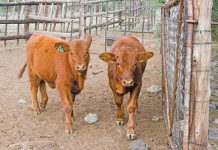The annual report of the KwaZulu-Natal Agricultural Union, which marked the 10th anniversary of its formation, contained some interesting information in the commodity reports. Joe Spencer provides a summary.
SA Cane Growers’ Association (Canegrowers)
Jane Ferguson reported that despite production costs increasing at a greater rate than the selling price of sugar, the industry was alleviating some of the pressure on sustainability by increased efficiency. In the current season a crop of over 20 million tons of cane was produced. On the subject of land reform, Ferguson stressed the Cane Growers Association embraced the necessity for both land restitution and redistribution. However, she said it appeared the relevant authorities had failed to resolve the challenges arising from the land claims process.
An exciting recent event was the launch by the minister of Agriculture and Land Affairs of the Canegrowers Female Farmer Network. This initiative is aimed at promoting female leaders in the sugar industry.
KZN Cotton Growers’ Association
Phenias Gumede reported the production of cotton in KwaZulu-Natal was set to fall by about 25% from the previous season. This was in line with the national situation where overall production was about 20% down on previous years. The reasons for the drop are low international cotton prices due to subsidies in other cotton-producing countries; the relative strength of the rand; more favourable prices; and better returns from other crops. The entire KZN cotton crop of about 10 000 bales is produced by small-scale farmers, mainly in the Makhathini area. More than 300 of these farmers have attended Cotton SA’s skills training courses since 2001.
Pineapple Growers Association
Adriaan Kleyn said the climate and rainfall had been favourable for pineapple production. Results of research by the ARC on the testing of new cultivars should be available later this year, and a farmers’ day in collaboration with the ARC is planned. There was no Pineapple Festival in 2007, but the event will return next year, combined with the Pineapple Off-road National Championships.
KZN Red Meat Producers’ Organisation (RPO)
Mike Phillips said the red meat industry had enjoyed an extended period of prosperity, partly due to good management by the organisation. Red meat appears to have regained its place in the South African diet. The first combined meeting of the RPO and the National Emergent Red Meat Producers Organisation, now fully integrated as the Federation of Red Meat Producers, was held in July.
KZN Pork Producers’ Organisation (KZNPPO)
Barry Gibbs told us that during the year the KZNPPO had embarked on a four-month campaign to promote fresh South African pork. The organisers won enthusiastic support from all the supermarkets and major butcheries for what turned out to be a very successful initiative. The statutory levy is running effectively and funds for future promotions should be available.
Forestry South Africa (FSA)
Roger Godsmark said FSA had had a busy year with issues that had a direct impact on members. These included BEE, where a transformation charter had been drafted, water issues including the establishment of catchment management agencies, environmental matters and a research symposium. Work had been done to establish structures to represent the 15 000 emerging growers who are members of FSA
National Wool Growers Association of KZN
Bom Louw reported that a new strategy of regional meetings had been introduced, the main topics being stock theft and the control of animal predators. Solutions discussed included Anatolian sheepdogs, rangers (using cellphone technology), electric fencing and protective collars. The association participated in the Pietermaritzburg Royal Show, winning a gold medal for its display. More than 4 000 people attended the shearing demonstrations.
Milk Producers’ Organisation of KZN
Quentin Simpson said the year had been one of contrasts and the industry had turned around in a very short time. The shortage of dairy products had resulted in a price increase, stopping some of the imports that were keeping local prices down. Some farmers had left the industry but the remaining producers had compensated for this by increasing the sizes of their herds. Meetings with supermarket chains had highlighted the lack of consumer education.
KZN Poultry Institute
Kevin Barnsley reported the institute had been heavily involved in the training and development of poultry skills, the scale of which was quite daunting as the poultry industry, in all its forms, was the largest sector in the agricultural economy. The demand for poultry meat was expected to rise from the current 24kg per head per annum to 31kg by 2016. He said some form of training was essential to improve poultry-farming competency.








